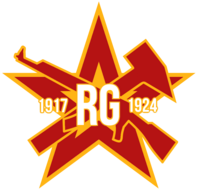Revolutionary Garrison: Difference between revisions
No edit summary |
No edit summary |
||
| Line 24: | Line 24: | ||
The '''Revolutionary Garrison''' ('''RG'''; {{wp|German language|Hesurian}}: '''''Revolutionärsgarnison'''''), also known as the '''Red Gardists''' or '''Weststädt–Zeiner Fraction''' (''Rote Gardisten'', ''Weststädt–Zeiner–Fraktion''), was a {{wp|far-left politics|far-left}} {{wp|communism|communist}} militant organization in [[Mascylla]] from 1958 until its dissolution in 1987. Key figures and ''de facto'' leaders of the group include Guido Weststädt, Henriette Müller, Bartosz Zeiner and Rudolph Mahlhof, among various other individuals of unknown identity. The Mascyllary government, in agreement with the governments of Lavaria, Lilienburg, Krumlau and Finstria, as well as most Eastern media outlets and literature considered the RG to be a {{wp|terrorism|terrorist organization}}. | The '''Revolutionary Garrison''' ('''RG'''; {{wp|German language|Hesurian}}: '''''Revolutionärsgarnison'''''), also known as the '''Red Gardists''' or '''Weststädt–Zeiner Fraction''' (''Rote Gardisten'', ''Weststädt–Zeiner–Fraktion''), was a {{wp|far-left politics|far-left}} {{wp|communism|communist}} militant organization in [[Mascylla]] from 1958 until its dissolution in 1987. Key figures and ''de facto'' leaders of the group include Guido Weststädt, Henriette Müller, Bartosz Zeiner and Rudolph Mahlhof, among various other individuals of unknown identity. The Mascyllary government, in agreement with the governments of Lavaria, Lilienburg, Krumlau and Finstria, as well as most Eastern media outlets and literature considered the RG to be a {{wp|terrorism|terrorist organization}}. | ||
Though engaging in political and civil manner at first, the RG quickly resorted to more violence acts such as {{wp|bombing|bombings}}, {{wp|assassination|assassination}}, {{wp|kidnapping|kidnappings}}, shoot-outs and taking {{wp|hostage|hostages}} over the course of its activity. Their activity reached its peak in summer of 1976 as the infamous "Summer of Knifes" which triggered a nation-wide crisis. The attacks on 20 | Though engaging in political and civil manner at first, the RG quickly resorted to more violence acts such as {{wp|bombing|bombings}}, {{wp|assassination|assassination}}, {{wp|kidnapping|kidnappings}}, shoot-outs and taking {{wp|hostage|hostages}} over the course of its activity. Their activity reached its peak in summer of 1976 as the infamous "Summer of Knifes" which triggered a nation-wide crisis. The [[July 20 attacks|attacks on July 20 1976]] have been the worst {{wp|terrorist attack|terrorist attacks}} in Mascyllary history, with instrumental political institutions such as the Reichsrat crippled, and around 504 people dead. The RG as of a ruling of the High Court of the Realm from 2015 has been held responsible of atleast 687 deaths, including secondary targets and collateral damage such as civilians, chauffeurs, and bodyguards. Thre have also been numerous cases of {{wp|torture}} to the kidnapped. A total of 500 attacks have been conducted by the RG, making it the most deadly terrorist organization to have engaged in Mascylla. | ||
[[Category:Mascylla]] | [[Category:Mascylla]] | ||
Revision as of 17:33, 23 February 2020
This article is incomplete because it is pending further input from participants, or it is a work-in-progress by one author. Please comment on this article's talk page to share your input, comments and questions. Note: To contribute to this article, you may need to seek help from the author(s) of this page. |
| Revolutionary Garrison | |
|---|---|
| Revolutionärsgarnison (Hesurian) | |
 Design of the RG's insignia showing a Hytekojuznik hammer and an AK-74 gun | |
| Leaders | Guido Weststädt Henriette Müller Bartosz Zeiner |
| Dates of operation | 1958–1981 (criminal activity up to 1987) |
| Active regions | Mascylla Lilienburg Finstria |
| Ideology | Anti-fascism Anti-imperialism Anti-capitalism Communism Aivarism Viliksism |
| Part of | Great Game |
| Allies | |
| Opponents | |
| Battles and wars | Mascyllary embassy in Lilienburg bombing, July 20 attacks, Eagle Air flight 182, Crethian Airways flight 255, Summer of Knifes |
The Revolutionary Garrison (RG; Hesurian: Revolutionärsgarnison), also known as the Red Gardists or Weststädt–Zeiner Fraction (Rote Gardisten, Weststädt–Zeiner–Fraktion), was a far-left communist militant organization in Mascylla from 1958 until its dissolution in 1987. Key figures and de facto leaders of the group include Guido Weststädt, Henriette Müller, Bartosz Zeiner and Rudolph Mahlhof, among various other individuals of unknown identity. The Mascyllary government, in agreement with the governments of Lavaria, Lilienburg, Krumlau and Finstria, as well as most Eastern media outlets and literature considered the RG to be a terrorist organization.
Though engaging in political and civil manner at first, the RG quickly resorted to more violence acts such as bombings, assassination, kidnappings, shoot-outs and taking hostages over the course of its activity. Their activity reached its peak in summer of 1976 as the infamous "Summer of Knifes" which triggered a nation-wide crisis. The attacks on July 20 1976 have been the worst terrorist attacks in Mascyllary history, with instrumental political institutions such as the Reichsrat crippled, and around 504 people dead. The RG as of a ruling of the High Court of the Realm from 2015 has been held responsible of atleast 687 deaths, including secondary targets and collateral damage such as civilians, chauffeurs, and bodyguards. Thre have also been numerous cases of torture to the kidnapped. A total of 500 attacks have been conducted by the RG, making it the most deadly terrorist organization to have engaged in Mascylla.